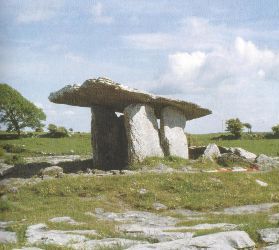|
Poulnabrone - Prehistoric Billboard or Ancient Monument?Poulnabrone was a place of rituals. It may also be a giant megalithic street sign designed to make it clear who ruled the neighborhood By Carleton Jones I’ve had the privilege of studying, surveying and excavating archaeological sites of many types across Ireland. The experiences have ranged from the pleasant summer excavations to the grim wintertime digs where the muddy, frozen trenches resemble a scene from the First World War. The sites have ranged from massive stone monuments built by Ireland’s first farmers to an Early Medieval souterrarin - a complex underground passageway with trap-doors and secret air holes. Out of all these, the sites that interest me the most are the massive prehistoric stone constructions known as megalithic tombs.
Poulnabrone, the first megalithic tomb I encountered in Ireland, is still one of my favorites. It was built to impress, and it still does over 5,000 years later. It forms a striking silhouette that catches your eye from afar and is a solid testament to the strength and cohesion of the group that built it. In prehistory, as today, it was located on a main route into the Burren. One of its roles seems to have been that of a prehistoric billboard.” As a traveler entered the Burren from the north, the impressive bulk of Poulnabrone would leave no doubt in their mind that they were entering the Burren tribe’s territory. Mass and Energy Poulnabrone shows us that there are many ways to look at, experience, and explain a prehistoric monument. If you make a visit to Ireland, Poulnabrone and the other megalithic tombs on the Burren are well worth a visit. Just keep an open mind! Poulnabrone is near Ballyvaughn, on the Corfin – Ballyvaughn road. More information about the archaeology of the Burren and the Aran Islands can be found in the recently published book by Dr. Carleton Jones: The Burren and the Aran Islands – Exploring the Archaeology. Published by Collins Press, West Link Park, Doughcloyne, Wilton, Cork, Ireland. www.collinspress.com Dr. Carleton Jones is a Lecturer in the Archaeology Department, National University of Ireland, Galway.
|
 Owning the Territory
Owning the Territory